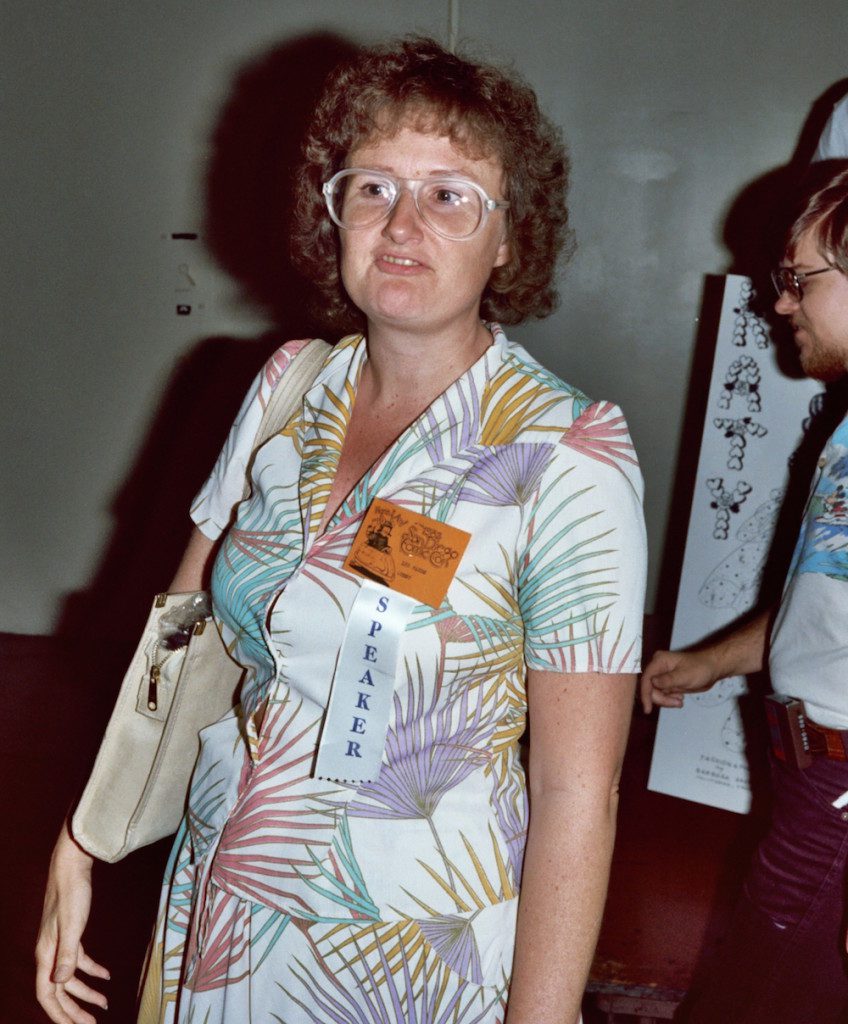That’ll be the name of the documentary that gets made when people learn to love Lee Marrs. Who is Lee Mars? Honestly, I don’t really know who she is. I’m sure I could ask her. I could actually call her on the phone. I have her number right here. I could even show up at her doorstep in Berkeley, for crying out loud. She boldly lists this info on her website, as if to say, “You want me, come get me. I dare you.” But I don’t dare.
Lee Marrs is one of the underground cartoonists—pardon me, women underground cartoonists, as they are always credited—of the 1970s. She was one of the founding members of the longest running, all-women comics anthologies—Wimmen’s Comix—and was a constant contributor to Howard Cruse’s Gay Comix. She also created her own underground comic that ran 1973-1978 called, The Further Fattening Adventures of Pudge, Girl Blimp. She contributed to Wet Satin, Manhunt, El Perfecto, and other underground comics anthologies of the 1970s. And I could go on.
She also worked in mainstream comics. She actually started there right out of college, creating background art for comics like Prince Valiant and Little Orphan Annie. Even while she was working on one-off stories for the undergrounds—with titles like, “Cybergenetics: The Everyday Housewife,” “Equal Rites,” and “Mommy, Are You the Biggest Witch in the World?”—she was also working for DC’s horror and mystery anthologies, Weird Mystery Tales, and House of Secrets.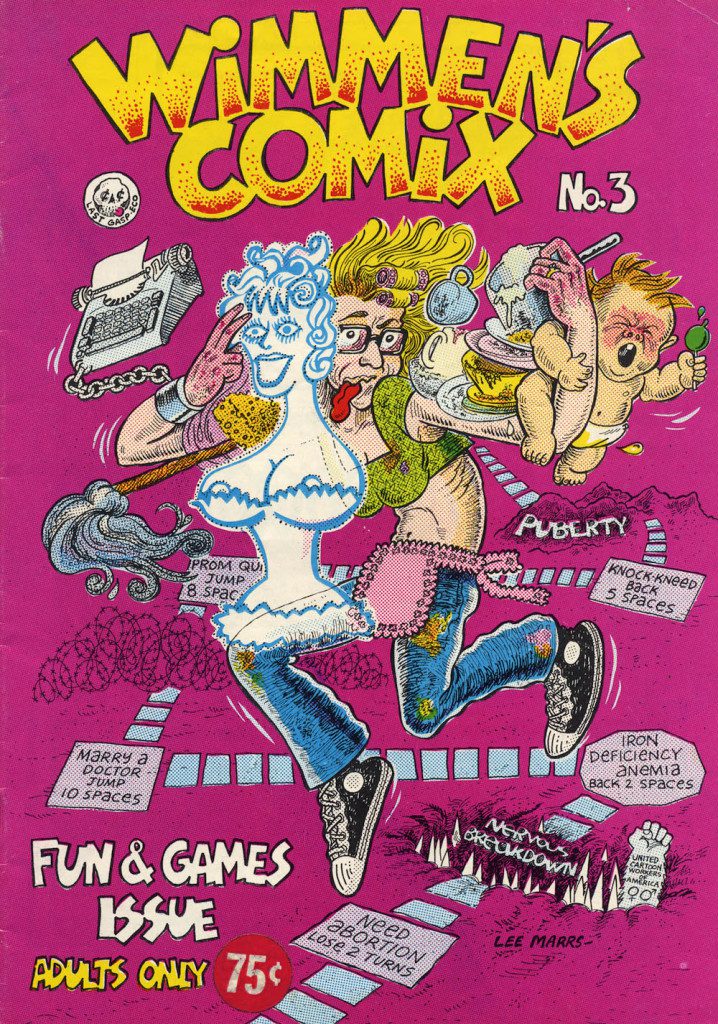 In 1975 she created a series about growing up female for Marvel Comics’ Crazy magazine. Later, in the 80s and 90s, she worked mostly as a writer for comics like Viking Glory: the Viking Prince, Wonder Woman Annual, Zatanna: Come Together, and Indiana Jones and the Arms of Gold. And then there was what I consider her crowning achievement in hilarity, the Pre-Teen Dirty-Gene Kung Fu Kangaroos, a Teenage Mutant Ninja Turtles parody. It only ran for three issues, but come on—that’s funny.
In 1975 she created a series about growing up female for Marvel Comics’ Crazy magazine. Later, in the 80s and 90s, she worked mostly as a writer for comics like Viking Glory: the Viking Prince, Wonder Woman Annual, Zatanna: Come Together, and Indiana Jones and the Arms of Gold. And then there was what I consider her crowning achievement in hilarity, the Pre-Teen Dirty-Gene Kung Fu Kangaroos, a Teenage Mutant Ninja Turtles parody. It only ran for three issues, but come on—that’s funny.
Lee Marrs has been busy making comics for a long time. So why isn’t she a household name like Robert Crumb or Gilbert Shelton or even Aline Kominsky? Of course I’m referring to those rare households like mine that know and care about underground cartoonists. Is it because she’s a woman? Or because she’s not a certain type of woman? I like to think it’s because she actually doesn’t care whether you know about her or not. She is a master of her craft, and she’s unstoppably funny. Her work is all the evidence you need to know that she’s having a great time without any of us knowing about her. That’s pretty baller.
*
The Compleat Fart (1976) is the work that first caught my attention. While so many other women underground cartoonists were reclaiming the right to their own bodies in the wake of Roe v. Wade with comics like Abortion Eve and Tits n’ Clits, Marrs was reclaiming hers by reveling in its grotesqueries—namely, burps, pimples,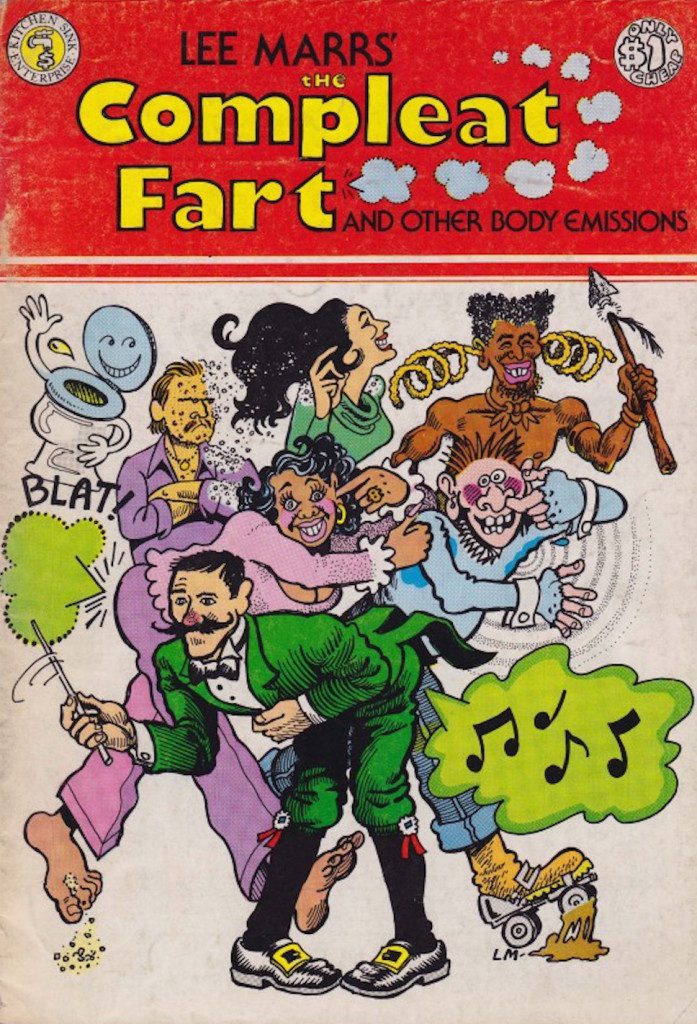 dandruff, BO, flatulence, “and other bodily emissions.” Instead of the instructional PSA-style messaging that typified other women’s comics of the day, The Compleat Fart offered a broader argument to embrace the full body and all of its naturalness. “Farting Down the Ages” recounts moments in fart history, from prehistoric man to the Dark Ages, from the Renaissance to the US Civil War and on to present day. “The Dialectics of Sweat” challenges the social anxiety du jour—letting them see you sweat—by equating it with a tool of Capitalist oppression. For Marrs, the key aspect of the class struggle was articulated brilliantly by Karl Marx in his infamous, immortal essay: “Value, Price and Perspiration.” This is the stuff of National Lampoon or Monty Python’s Flying Circus. Her advertisement for “Seal-A-Body” on the back cover reads just like a spoof ad from Saturday Night Live, which was only in its second season at the time of publication.
dandruff, BO, flatulence, “and other bodily emissions.” Instead of the instructional PSA-style messaging that typified other women’s comics of the day, The Compleat Fart offered a broader argument to embrace the full body and all of its naturalness. “Farting Down the Ages” recounts moments in fart history, from prehistoric man to the Dark Ages, from the Renaissance to the US Civil War and on to present day. “The Dialectics of Sweat” challenges the social anxiety du jour—letting them see you sweat—by equating it with a tool of Capitalist oppression. For Marrs, the key aspect of the class struggle was articulated brilliantly by Karl Marx in his infamous, immortal essay: “Value, Price and Perspiration.” This is the stuff of National Lampoon or Monty Python’s Flying Circus. Her advertisement for “Seal-A-Body” on the back cover reads just like a spoof ad from Saturday Night Live, which was only in its second season at the time of publication.
Not only is it hard to believe that Marrs wasn’t scooped up as a comedy writer during the 1970s avalanche of boomer-humor publications and television shows, it’s also hard to accept that Pudge, Girl Blimp isn’t as widely acknowledged as other underground characters like Mr. Natural, Fritz the Cat, and the Fabulous Furry Freak Brothers. Pudge 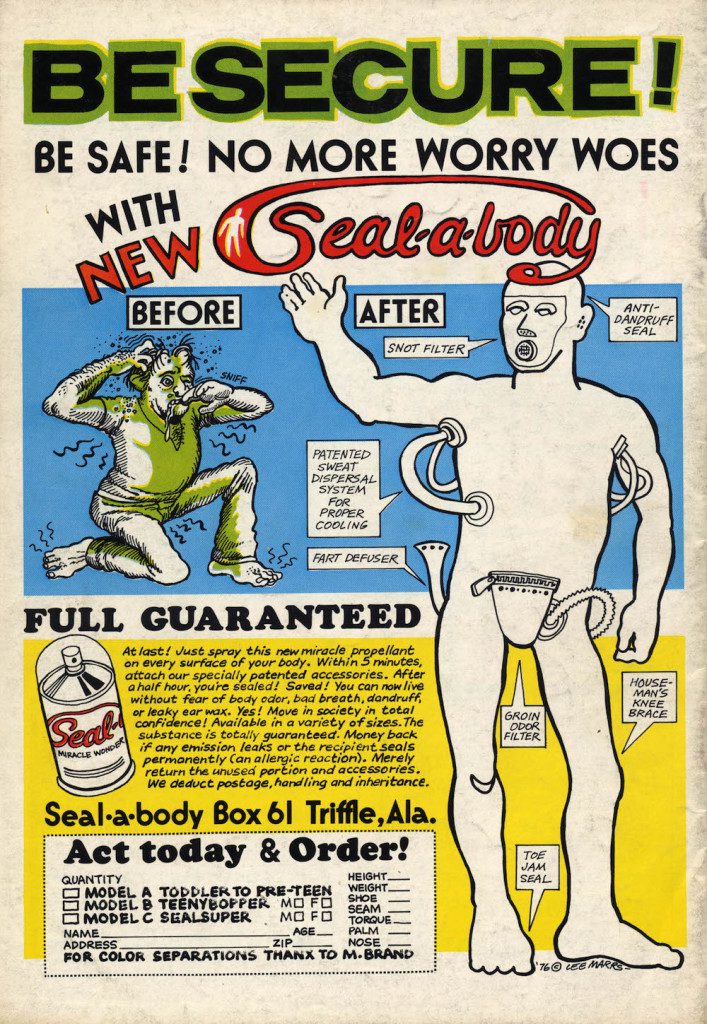 was a 17-year-old runaway who thumbed her way to San Francisco, a penniless and chubby virgin determined to do many things, but mostly to have sex. She was a sweet kid who was well-liked by her adopted community of burnouts, revolutionaries, and transcendentalist devotees, but in some ways she just couldn’t catch a break. Her plumpness encouraged a physical comedy of mishaps—she did a lot of slipping and falling—but it also reminded the reader that she was still a child. Pudge was curious about the world and genuinely wanted to participate in it. She represented the part of each of us that is awkward and naive, and perhaps our willingness to laugh along with Pudge inspires us to accept the parts of us that are just trying—sometimes unsuccessfully—to do new things.
was a 17-year-old runaway who thumbed her way to San Francisco, a penniless and chubby virgin determined to do many things, but mostly to have sex. She was a sweet kid who was well-liked by her adopted community of burnouts, revolutionaries, and transcendentalist devotees, but in some ways she just couldn’t catch a break. Her plumpness encouraged a physical comedy of mishaps—she did a lot of slipping and falling—but it also reminded the reader that she was still a child. Pudge was curious about the world and genuinely wanted to participate in it. She represented the part of each of us that is awkward and naive, and perhaps our willingness to laugh along with Pudge inspires us to accept the parts of us that are just trying—sometimes unsuccessfully—to do new things.
On top of her inspired comedic writing, Marrs’s mark-making was superb—loose and confident in a way that stood out from her peers. Although this is true of most of her drawing, her cover art was especially frenzied and playful. Her characters are often in the throws of frantic activity and seem pleasantly hypnotized. I picture a woman, one who seems to have never looked like a girl, hunched over her drafting table calmly and steadily cracking herself up. Her comics are so graphically dense that you know she spent obsessively long hours in that bent posture, sketching, inking, and touching up. I hesitate to do so because it seems cliche, but it’s hard not to compare her work to R. Crumb’s. There’s a similar irreverence and psychedelic goofiness. 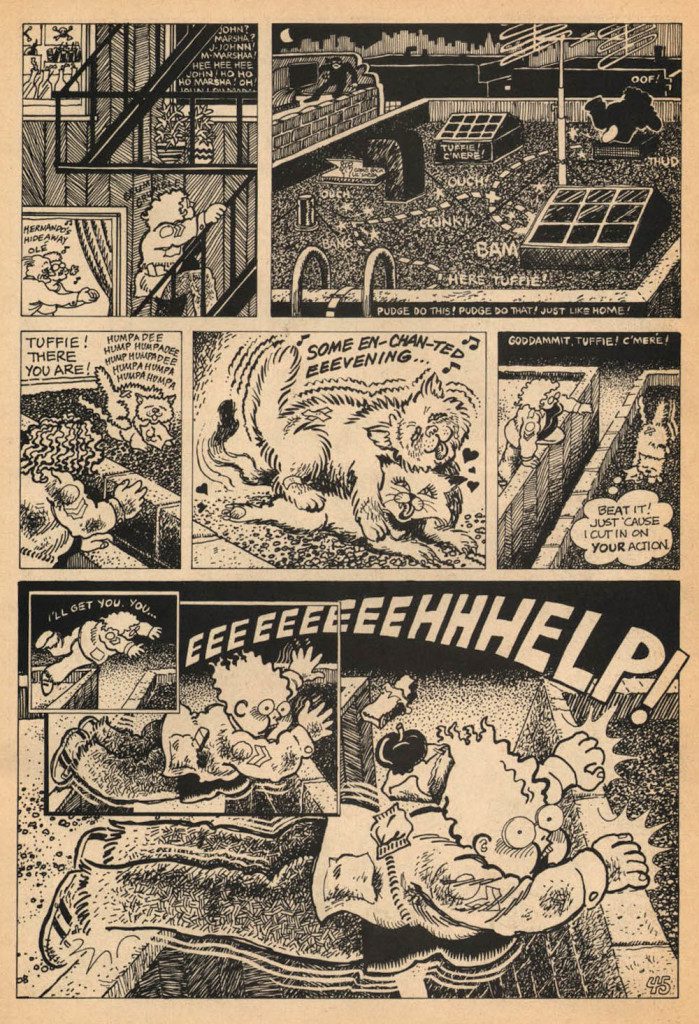 But, again, her brand of comedy is more like the early surrealist humor of SNL. Like when Lorne Michaels just couldn’t let go of that Bee sketch. For example, Captain Kangaroo and Woody Allen—inexplicably represented as two Martians—skulk at the periphery of Pudge’s storyline. Wherever she goes, Woody and the Captain lurk behind garbage cans, speaking Martian to each other.
But, again, her brand of comedy is more like the early surrealist humor of SNL. Like when Lorne Michaels just couldn’t let go of that Bee sketch. For example, Captain Kangaroo and Woody Allen—inexplicably represented as two Martians—skulk at the periphery of Pudge’s storyline. Wherever she goes, Woody and the Captain lurk behind garbage cans, speaking Martian to each other.
Later in life, Marrs went on to work in art direction and animation, primarily for television, and she even won an Emmy. She got her Master’s Degree in Multimedia Arts at age sixty, and last I heard she was Head of the Multimedia Arts Department at Berkeley City College. She has developed curriculum and has taught courses on any number of topics having to do with storytelling, animation, digital media, drawing, and user-centered design. Her students have described her as tough, challenging and quick-witted.
*
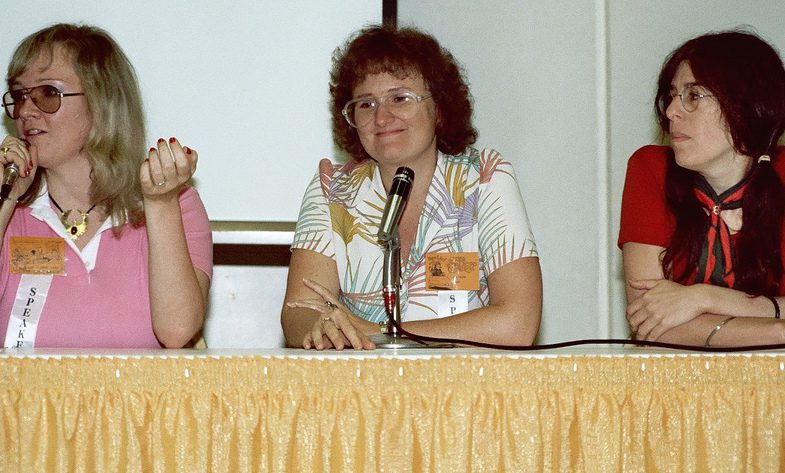 So, Lee Mars—are you reading this? Does this sound like you? Wait, don’t answer. It’s better that you remain an enigma to me. You are wildly talented, a prolific creator and understated about your awesomeness. You are a gem, and I don’t want to decode you too much. And besides, what if you answered me in a really annoying, squeaky voice or something. I couldn’t handle that.
So, Lee Mars—are you reading this? Does this sound like you? Wait, don’t answer. It’s better that you remain an enigma to me. You are wildly talented, a prolific creator and understated about your awesomeness. You are a gem, and I don’t want to decode you too much. And besides, what if you answered me in a really annoying, squeaky voice or something. I couldn’t handle that.
***
Photographs of Lee Marrs © Alan Light.

